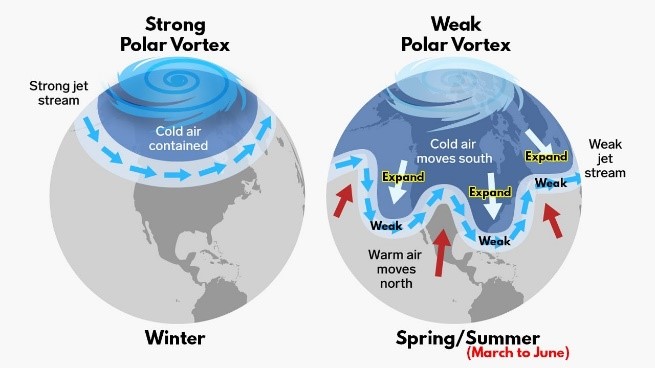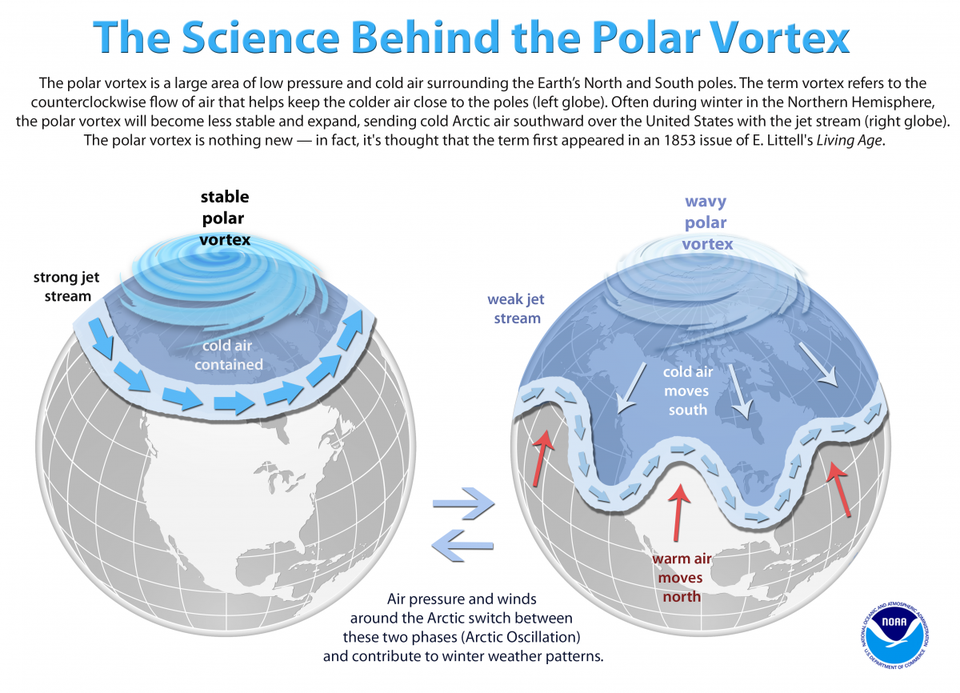Description

Disclaimer: Copyright infringement not intended.
Context:
- Asia has had a really cold month. China’s northernmost city, recorded a temperature of minus 53 deg C this week.
- South Asia is having a chilly winter, too. Several Indian states experienced “severe cold wave conditions” in mid-January. Asia’s extreme cold is largely the result of the so-called polar vortex.
Polar Vortex:
- Polar vortex, is a large region of cold, rotating air that encircles both of Earth's polar regions.
- Polar vortex ALWAYS exists near the poles, but weakens in summer and strengthens in winter.
- The term "vortex" refers to the counter-clockwise flow of air that helps keep the colder air near the Poles.
- Many times, during winter in the northern hemisphere, the polar vortex will expand, sending cold air southward with the jet stream.
- It rotates counter-clockwise at the North Pole and clockwise at the South Pole, i.e., both polar vortices rotate eastward around the poles. The vortices weaken and strengthen from year to year.
- As with other cyclones, their rotation is driven by the Coriolis effect.
- Ozone depletion occurs within the polar vortices – particularly over the Southern Hemisphere – reaching a maximum depletion in the spring.
- The term polar vortex can be used to describe two distinct phenomena; the stratospheric polar vortex, and the tropospheric polar vortex.
- The stratospheric and tropospheric polar vortices both rotate in the direction of the Earth's spin, but they are distinct phenomena that have different sizes, structures, seasonal cycles, and impacts on weather.
.jpeg)
Stratospheric Polar Vortex
- The stratospheric polar vortex is an area of high-speed, cyclonicallyrotating winds around 15 km to 50 km high, poleward of 50°, and is strongest in winter.
- It forms in Autumn when Arctic or Antarctic temperatures cool rapidly as the polar night The increased temperature difference between the pole and the tropics causes strong winds and the Coriolis effectcauses the vortex to spin up.
Tropospheric Polar Vortex
- The tropospheric polar vortex is often defined as the area poleward of the tropospheric jet stream.
- The equatorward edge is around 40° to 50°, and it extends from the surface up to around 10 km to 15 km.
- Its yearly cycle differs from the stratospheric vortex because the tropospheric vortex exists all year, but is similar to the stratospheric vortex since it is also strongest in winter when the polar regions are coldest.


Read more about polar Vortex here: https://iasgyan.in/blogs/polar-vortex-28
https://www.straitstimes.com/asia/asia-has-had-a-really-cold-month-courtesy-of-the-polar-vortex

















